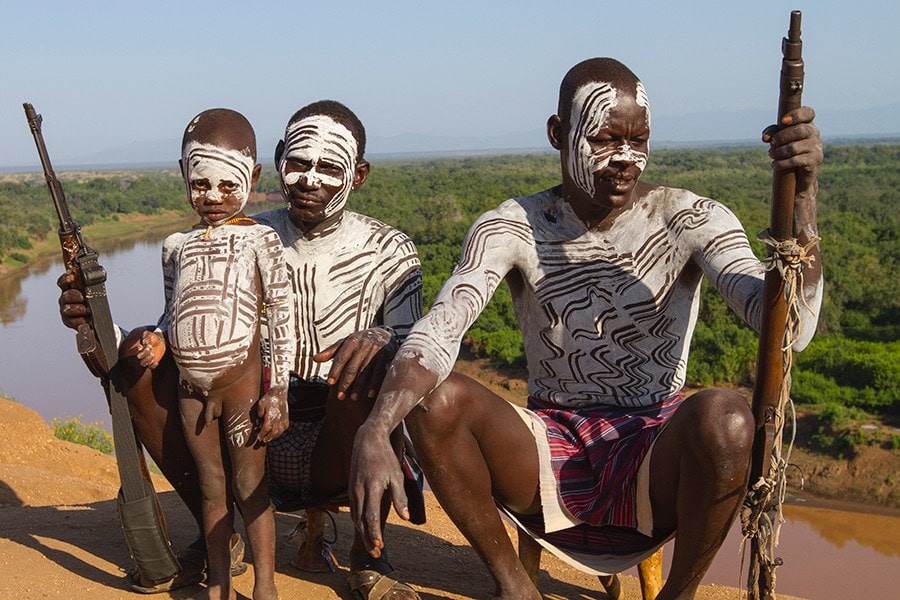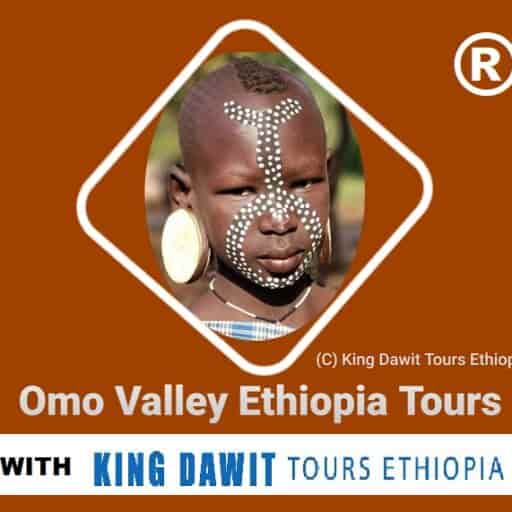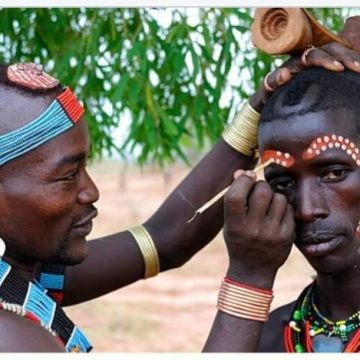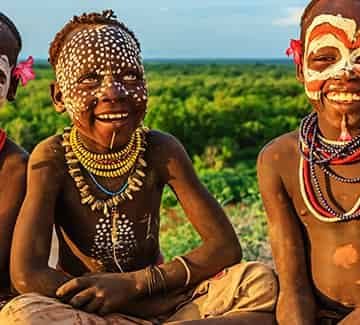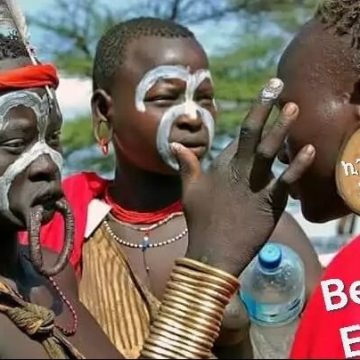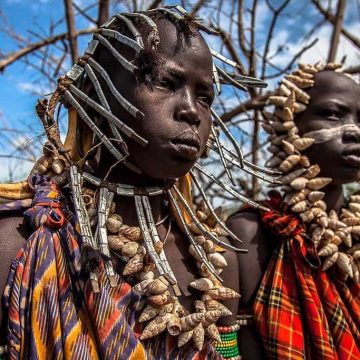6 Day Omo Valley Ethiopia Tour
 6-Day Omo Valley Ethiopia Tour by Flight
6-Day Omo Valley Ethiopia Tour by Flight
Introduction
The Lower Omo Valley Ethiopia is one of the most ethnically diverse parts that are found in the southwestern part of Ethiopia. The region is well known for the cultural diversity of over a dozen tribes.
It extends over an area of 165 km2. The age-old sedimentary deposits in the Lower Omo Valley are now world-renowned for the discovery of many hominid fossils that have been of fundamental importance in the study of human evolution.
Do you know How Many Tribes are in the Omo Valley? The answer is More than a dozen culturally diverse tribes. But on this short day trip, you will visit the most important tribes of the Omo valley.
Trip Highlight
- Addis Ababa Sightseeing (Menilik II Palace, National Museum, Lucy Hominid, Holy Trinity, and Ethnographic Museum).
- You will meet and visit many of the Omo Valley Ethiopia Tribes as possible.
- Arba Minch, Visit the village, boat trip to Lake Chamo & visit the crocodile farm.
- Attend Keyafer and Dimeka Local Markets if you arrive on market days.
- Visit and meet the Konso people and their cultivation system.
- Explore Mago National Park and visit the Mursi Tribes.
- Excursion to Murulle and visit to the Karo tribes.
- Enjoy the stunning view of the Omo River Valley at Dus Village.
- Meet the Hamer people in Turmi, visit their villages, and participate in their occasional and optional events such as bull jumping and the Evangadi dance.
- You will learn a lot about Omo Valley Ethiopia culture and visit the Omo valley.
Itinerary:
Day 1: Arrive in Addis Ababa and spend the day exploring the city.
- You will be welcomed at the airport upon arrival in Addis Ababa and driven to the hotel. Addis Ababa was founded in 1886 by Menelik II, and it is the third-highest capital city in the world thanks to its elevation of about 2438 meters.
- The National Museum, which is home to some of the nation’s historic treasures, will be where we begin our sightseeing. The 3.5 million-year-old remains of “Lucy,” the oldest hominid ever unearthed, are among the collection of early hominid fossils and bones recovered in Ethiopia.
- Continue on to the two main attractions of the city: the Ethnographic Museum and the Church of the Holy Trinity, which serves as Ethiopia’s primary cathedral and is where Haile Selassie, the last emperor, is buried.
Night at the hotel
Day 2: Fly from Addis Ababa to Arba Minch, then to Chencha and Dorze-Arba Minch.
- Have a sightseeing tour of Addis Ababa in the morning, and then transfer to the airport for our flight to Arba Minch.
- Our 4WD car and driver will be waiting for us at Arba Minch Airport, and we will then begin the 40-kilometer drive to the Guge Mountains in the northwest, where we will visit the Dorze and Chencha villages.
- The Dorze name is a byword for the finest-woven cotton fabric, and they communicate in an Omotic language. Additionally, the Dorze beehive-shaped homes have their own tiny gardens with beds of herbs, cabbage, and tobacco, and they are made entirely of organic materials. Some of Ethiopia’s best-woven pieces of cotton are produced in Chencha, which is situated 8 kilometers to the northwest of Dorze Village. Women spin while men weave.
- Then retrace your steps back and continue to Arba Minch for the night.
Night at the hotel/lodge/resort
Day 3: Travel to Jinka via Konso and Keyafer
- Early in the morning, take a trip to Konso to observe the women dressed in vibrant costumes, the amazing terracing of the land, and the strangely etched wooden figures used as burial markers.
- In contrast to their neighbors, the Konso are solely farmers and are renowned for their skillful utilization of the stone terraces found in this desolate region of basalt hills.
- The Konso are a people that originated in the east and who speak an eastern Cushitic language. They reside in towns that are enclosed by stone walls. Each family lives in a compound that is only accessible through gateways that compel the visitor to enter on all fours, making any prospective attackers vulnerable. Each family lives in a compound that is only accessible through gateways that allow the visitor to enter on all fours, making any prospective attackers vulnerable. The age of each town is determined by a generation pole.
- Continue traveling until you reach Key Afer for the vibrant Thursday market where we can observe and take pictures of the Ari, Bena, Hamer, and Tsemay people. The women of Bena and Hamer commonly wear their hair in red clay braids that are shiny from butter and perfumed from incense. The Tsemay wear long beaded skirts with a stick tied into the back to signify a married woman, while the men wear elaborately plaited hairstyles decorated with feathers and vibrant beads.
- After visiting the market, we continue on to Jinka, which is commonly referred to as the Omo Valley Ethiopia doorway.
The night will be at the lodge or resort.
Day 4: Drive to Mago National Park, then to the Mursi Tribes before returning to Turmi.
- Drive to Mago National Park in the morning. From here, travel to the Mursi highlands, home to Ethiopia’s most illustrious tribes.
- Mursi women’s lower lips are adorned with beautiful lip plates, which are well-known around the world. The plates extend the lower lip beyond belief, and the size of the plate directly affects a woman’s beauty, pride, and desirability. Although the Mursi men and women have charming appearances, the Mursi warriors are nothing to be taken lightly. Each adversary they have defeated in battle is commemorated by a deep crescent cut on their arms. The haircuts of guys are as well-known.
- You will be given an explanation of the tribe’s numerous cultural practices and given the option to snap their pictures, though not for free.
- Return to Jinka for lunch.
- We’ll keep traveling through the Omo Valley Ethiopia in the afternoon in order to see the Hamer tribes in Turmi through Dimeka. One of the biggest tribes in the valley is the Hamer. They are renowned for both their amazing hairstyles and the wonderful pottery they produce.
- The most impressive of these are the men’s clay-hair buns with ostrich feathers that they adorn after killing a hazardous animal. The Hamer women are absolutely gorgeous. The women paint their skin with cowry shells and wear beaded necklaces and iron coils around their arms. These decorations indicate the wealth and prestige of a woman’s husband.
The night will be at the hotel, lodge, or resort.
Day 5: Murulle Excursion, Karo Tribes-Back tto Turmi, and continue to Arba Minch.
- On our way to the Murulle region this morning, we pass through a vast meadowland densely forested with shrubs and umbellifers (‘umbrella’ acacia trees) along barely discernible savannah pathways.
- The Karo ethnic group, experts in body painting, may be seen utilizing clay and locally available vegetable pigments to paint magnificent patterns on one another’s faces, chests, arms, and legs when we arrive at Korcho village, with its lovely views of the Omo River.
- These designs are made solely for pleasure and aesthetic impact, with each artist competing to outdo their peers, and having no unique symbolic meaning. The hair of Karo men is likewise sculpted and shaved into ornate designs, with distinctive ochre “caps” of hair that typically include a number of ostrich feathers.
- In the early afternoon, we will start driving back to Turmi and continue to Arba Minch.
Overnight will be at the hotel/lodge/resort.
Day 6: Boat ride on Lake Chamo, followed by a visit to a crocodile farm. Then fly back to Addis-Evening Departure.
- We will have a boat ride this morning on the crystal-clear waters of Lake Chamo to view crocodiles, hippos, and several aquatic bird species. Huge crocodiles, which can be seen in large numbers relaxing in the sunlight on the northern banks of Lake Chamo, are renowned for being there.
- The lake is around 32 kilometers long and is a rich wetland environment for numerous types of flora and fauna.
- Then, in the middle of the day, we transfer to Arba Minch Airport to catch our flight back to Addis Ababa. We will arrive in Addis Ababa in the late afternoon and be transferred to the hotel where we will have a day room to utilize for getting ready for the evening flight and doing laundry or changing. You’ll have enough time for a quick shopping trip.
- We will go out to a top cultural restaurant in the evening for a farewell dinner and a live performance of traditional dances.
- You will then be transferred to the airport for your departure flight back home.
—End of the 6-day Omo Valley Ethiopia tour by flight…
If you would like to book a 7-day Omo Valley Ethiopia Tour from Arba Minch please see the itinerary details from the above link.
Book Your 6 Days Omo Valley Ethiopia Tribes Tour Now!
